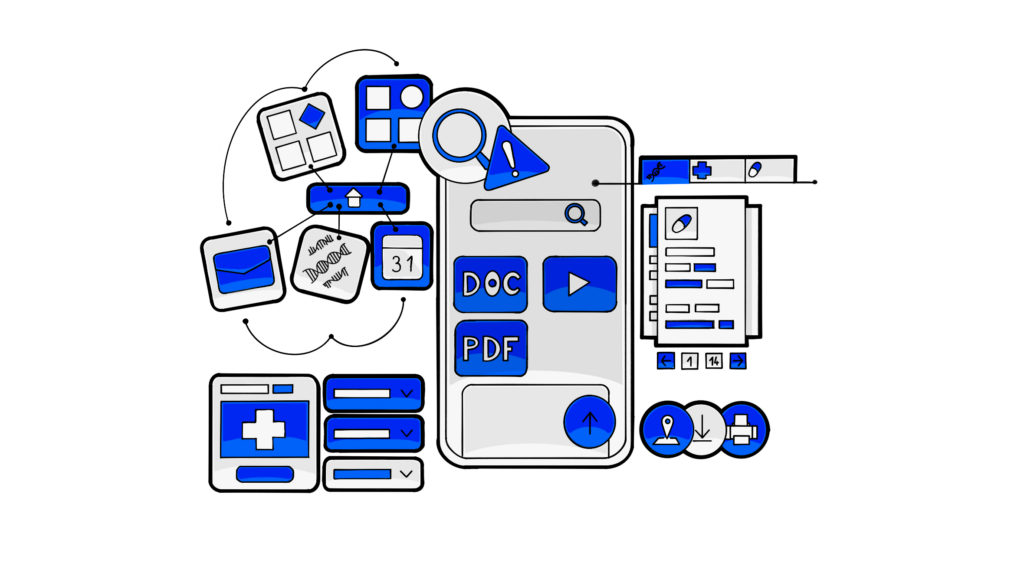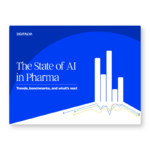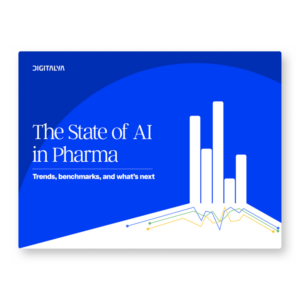1. We asked 200 pharma leaders about AI
The results, captured in The State of AI in Pharma market research, reveal where the industry stands today — from AI adoption rates and investment priorities to the challenges slowing progress and the optimism driving what’s next.
We wanted to cut through the noise. We asked over 200 pharma professionals across Europe, North America, and Asia to help us see the full picture:
- How far along are they in adopting and scaling AI?
- Which areas are seeing real impact?
- What’s still holding them back?
The result is The State of AI in Pharma — our latest market research that uncovers adoption trends, investment patterns, and readiness factors shaping the next phase of digital transformation in the pharmaceutical industry and life sciences.
The pharmaceutical market is experiencing rapid growth, with AI generating significant value and driving innovation as major pharmaceutical companies leverage these technologies.
AI technologies, including deep learning, natural language processing, and predictive analytics, are transforming the industry at every stage.
This report is built on data directly from those leading the transformation. The insights show not only where pharma stands today but also how leadership, process, and investment combine to determine AI success.
Want the full data?
Download the complete “State of AI in Pharma” report to see how your organization compares to others in adoption, maturity, and readiness.
2. AI adoption is accelerating, but maturity is uneven
Our data shows that AI in the life sciences and pharmaceutical industries is moving past experimentation. Nearly 7 in 10 pharmaceutical organizations are already piloting or using AI solutions across their organizations — proof that the industry is shifting from theory to action.
Pharma industries are experiencing significant trends in AI integration, with growing potential to transform healthcare and drug development, but they also face challenges such as data privacy, regulatory compliance, and the need for specialized talent.
33% of pharmaceutical companies are piloting AI, and 36.9% are already using it widely and cross-functionally. Only 1% have intentionally blocked AI as a strategic choice. Artificial intelligence is no longer a side project; it’s becoming part of pharma’s core infrastructure.
But while adoption is high, AI maturity remains uneven. Most companies are still in mid-stage development, building internal knowledge and scaling use cases department by department, including early AI applications in clinical trials, where predictive models help optimize study design and site selection.
These AI-driven approaches are paving the way for more efficient clinical trials, allowing pharma teams to reduce manual workload, improve site selection accuracy, and accelerate time-to-insight.
Only about 12% describe themselves as “advanced,” meaning they use AI strategically across multiple functions.
These advanced organizations are also experimenting with sophisticated AI models — from predictive analytics to generative AI — to scale insights across commercial and R&D functions.
Regional maturity gaps
Geography plays a major role in how quickly pharma AI evolves:
- Europe leads, with 87% of companies either piloting or scaling AI
- North America is evenly split across exploration, piloting, and adoption
- Asia-Pacific trails behind, with 23% of organizations reporting no current AI plans
This uneven process highlights a key insight: AI evolution depends more on ecosystem maturity than on company size or budget. Even smaller organizations are catching up by investing in agile, proof-of-concept initiatives that scale quickly when results appear — a sign of how AI maturity is reshaping the pharmaceutical industry globally.
The takeaway is clear — the adoption of AI in the pharmaceutical industry is rising fast, but the race is far from over. The next phase of progress will depend on turning pilots into enterprise-wide impact through better leadership, readiness, and governance.
3. Budgets are growing, but still cautious
Pharma companies are investing in AI — but not all are full throttle yet. While AI adoption is accelerating, most organizations are still treating it as a controlled experiment rather than a fully funded transformation.
According to The State of AI in Pharma report, 42% of pharma professionals said they don’t know how much of their digital budget is allocated to AI. This lack of visibility suggests that AI spending often happens informally — within pilot projects, proof-of-concept initiatives, or innovation budgets that sit outside of enterprise strategy.
Among those who track investments:
- 20% allocate less than 5% of their digital budget to AI
- 21% invest between 5-10%
- only 17% of companies dedicate more than 10% — the group most likely to have enterprise-wide AI programs.
This uneven spending points to a cautious mindset. Many pharmaceutical companies are still proving ROI before scaling, especially in highly regulated or cost-sensitive environments such as clinical trials, where demonstrating value and compliance takes time.
AI-driven efficiencies in drug development and clinical trials can yield significant cost savings for pharmaceutical companies, making a strong case for broader investment.
Budget does not equal adoption, but signals commitment
Interestingly, the report found no direct link between budget size and AI adoption stage. However, descriptive data shows clear trends:
- Smaller budgets (< 5%) — early exploration and planning
- Mid-range budgets (5-10%) — active piloting and experimentation
- Larger budgets (11-20%) — advanced, cross-functional adoption
In other words, the budget is not the cause of AI progress, but the result of it. Once pharma teams start to see measurable outcomes from AI, leadership becomes more confident in allocating resources.
Takeaway: cautious investment reflects not skepticism but pragmatism. Pharmaceutical companies are strategically testing where AI delivers the most impact, and using those results to justify future growth.
4. The biggest challenges for pharma AI
Even as the adoption of AI in the life sciences and pharmaceutical industries accelerates, one truth stands out: technology isn’t the biggest challenge; people and processes are.
Our research shows that the top barriers to AI adoption in pharma are deeply internal. Nearly half of all pharma leaders (46.5%) cite a lack of AI expertise and talent as their primary obstacle, followed by data availability, data quality issues (38.6%), and regulatory uncertainty (36.6%).
Data security and ethical considerations are also key concerns, especially as organizations manage sensitive information and strive to ensure responsible AI practices within regulatory frameworks. In this context, regulatory oversight is crucial to upholding patient and drug safety, ensuring that AI-driven pharmaceutical processes are transparent, effective, and prioritize patient well-being.
In other words, the challenge is whether pharma organizations are ready for it.
Internal readiness is the real differentiator
Pharma companies struggle to scale AI, not just because of limited budgets or vendors, but because of organizational and technical gaps. These include:
- Change management and stakeholder buy-in (26.7%) —AI often requires new ways of working that meet resistance
- Integration with legacy systems (24.3%) — existing infrastructures can’t always support AI workflows or the integration of advanced AI algorithms for optimization
- Undefined processes and governance — without clear SOPs, pilots don’t turn into scalable programs
- Technical and optimization challenges — robust AI systems are needed to ensure transparency, fairness, and explainability, especially as complexity increases
This explains why AI readiness and AI maturity are so closely connected. Companies with leadership support, strong data governance, and defined AI procedures are significantly more likely to move beyond pilots and achieve measurable business outcomes.
Early-stage companies struggle most with talent. Mature organizations, meanwhile, face more technical and optimization challenges, like integrating AI into existing systems or finding specialized vendors for complex tasks.
- Planning stage — 75% cite lack of talent as a top barrier
- Developing stage — legacy integration becomes the main issue
- Advanced stage — vendor selection and ecosystem optimization take priority
This evolution proves that AI maturity is a moving target — each step forward introduces new complexities to solve.
AI in the pharma industry isn’t held back by technology, but by readiness. To scale AI successfully, pharma leaders must invest in skills, data governance, and internal alignment just as much as in software or infrastructure.
5. Where pharma is investing in artificial intelligence today
AI investment in pharma is becoming strategic. Our data shows that pharmaceutical companies are putting their money where results are most visible: operational efficiency and commercial performance.
Nearly half of all organizations (48%) report investing in internal operations, and a similar number (47%) focus on marketing and omnichannel initiatives.
Many of these investments focus on implementing practical AI tools that automate reporting, optimize targeting, and analyze complex databases faster than traditional systems.
This dual emphasis reveals a clear pattern: AI is being used to cut costs through automation while driving revenue through smarter customer engagement — often powered by natural language processing (NLP) technologies that help analyze and personalize medical and marketing content at scale.
Top areas of AI investment in pharma
According to the report, the most common AI investment priorities are:
- Internal operations and automation (48%) — streamlining workflows, optimizing processes, and reducing manual effort.
- Marketing and omnichannel engagement (47%) — enhancing targeting, content personalization, and customer journey optimization.
- Customer experience and engagement (36%) — using AI for chatbots, predictive recommendations, and next-best-action insights.
- Sales force effectiveness (35%) — helping reps tailor outreach based on HCP data.
- R&D (34.5%) — enabling faster data analysis and optimizing clinical trials by improving decision-making, accelerating patient recruitment, and enhancing study design. AI is also streamlining and accelerating clinical development, resulting in improved efficiency and significant cost savings.
Areas such as medical affairs, regulatory, and legal are seeing slower uptake — reflecting the industry’s cautious approach in compliance-heavy functions.
AI maturity drives investment depth
The report also reveals a predictable but crucial pattern:
- Early adopters focus on customer-facing use cases like marketing and engagement
- Developing organizations expand into R&D and internal operations
- Advanced companies integrate AI into compliance and governance — using it for regulatory review, medical content approvals, and ethics monitoring.
This shows that as AI maturity grows, investment shifts from short-term wins to long-term transformation.
Pharma AI budgets are no longer about experimentation. They’re about scaling proven use cases and integrating AI across departments to deliver measurable impact, from commercial performance to compliance efficiency.
AI is transforming research, drug manufacturing, clinical trials, and drug development processes in the pharmaceutical industry, driving efficiency, reducing costs, and improving patient outcomes.
6. AI in pharma: optimism and what comes next
Despite the challenges, one message from pharma leaders is crystal clear: optimism around AI is high and growing.
According to the State of AI in Pharma, 62% of respondents rated their optimism about AI’s future impact as high or very high. Only 9% expressed low confidence. This overwhelming positivity shows that, even though pharma’s AI journey is complex, leaders believe it will transform the industry within just a few years.
What drives this optimism?
Our analysis found that optimism isn’t rooted in technology itself, but driven by organizational readiness and leadership support.
Pharma leaders who have:
- clear AI procedures and governance,
- strong executive buy-in, and
- defined measurement frameworks (KPIs),
are far more confident in AI’s long-term potential, especially given AI’s ability to analyze vast datasets, predict outcomes, and drive efficiency in drug discovery and development.
In short, optimism follows structure. Companies that see AI as a key tool — not just a test — are ready to gain its full value. This is especially true in areas like personalized medicine. Here, AI can customize treatments for each patient and enhance clinical results.
AI can further enhance patient outcomes by improving diagnostic accuracy, supporting decentralized clinical trials, and enabling continuous health monitoring.
The future of pharma AI
The next wave of innovation will push AI deeper into commercial, clinical, and compliance functions. According to the report, these are the three key trends shaping the future:
- Hyper-personalization and behavioral insights — AI will move beyond automation to understand HCP and patient behavior, using adaptive AI models that learn from interaction data to predict needs and personalize content in real time.
- Generative AI for regulated content — next-generation tools will help pre-screen materials against MLR standards, speeding up approvals and ensuring compliance.
- AI-powered commercial operations — from territory planning to predictive analytics, AI will optimize how sales and marketing teams work together.
This is where artificial intelligence shifts from proof of concept to business-critical infrastructure. The companies that invest now, in both talent and technology, will be the ones defining what “pharma innovation” means in 2026 and beyond.
What this means for pharma leaders
This AI transformation is mostly about readiness, culture, and leadership. The organizations that succeed will be those that:
- treat AI as a long-term strategic priority,
- build measurable KPIs to prove value, and
- foster cross-functional collaboration between digital, commercial, and compliance teams.
7. Why this research matters (and how to use it)
AI in the pharma industry is becoming the foundation for how it innovates, communicates, and competes. Yet, while almost every organization is exploring AI, only a few have turned ambition into scalable success.
This is exactly why the State of AI in Pharma exists.
This research provides pharma leaders with a clear view of the industry’s current state. It is supported by real-world data from over 200 professionals in Europe, North America, and Asia-Pacific.
It’s not just a report but a tool to help you understand AI. It shows how AI maturity, investment, and readiness work together. This can lead to better results in every area. This includes using the right AI tools, natural language processing, and managing patient data responsibly. It also covers AI-driven clinical trials and drug discovery.
How to use this research
- Benchmark your progress — compare your company’s AI maturity against global averages
- Spot opportunities — identify functions where AI adoption delivers the highest ROI
- Build strategy with confidence — use readiness data to align leadership, process, and technology
- Prioritize partnerships — learn how collaboration with external experts accelerates the adoption of AI
About the research
This report was produced by Digitalya, in collaboration with Graphite Digital, ctcHealth, and Camino Communications — a collective of experts shaping how AI technology, digital experience, and data intersect in the life sciences industry.
Together, we’re helping pharma teams move beyond pilots to enterprise-level AI transformation — building solutions that are ethical, compliant, and designed for impact.







